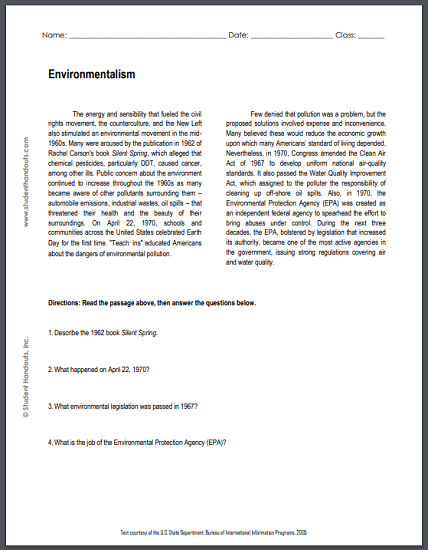Environmentalism |
The energy and sensibility that fueled the civil rights movement, the counterculture, and the New Left also stimulated
an environmental movement in the mid-1960s. Many were aroused by
the publication in 1962 of Rachel Carson's book Silent Spring,
which alleged that chemical pesticides, particularly DDT, caused
cancer, among other ills. Public concern about the environment
continued to increase throughout the 1960s as many became aware
of other pollutants surrounding them – automobile emissions,
industrial wastes, oil spills – that threatened their health and
the beauty of their surroundings. On April 22, 1970, schools and
communities across the United States celebrated Earth Day for
the first time. "Teach‑ins" educated Americans about the dangers
of environmental pollution. Few denied that pollution was a problem, but the proposed solutions involved expense and inconvenience. Many believed these would reduce the economic growth upon which many Americans' standard of living depended. Nevertheless, in 1970, Congress amended the Clean Air Act of 1967 to develop uniform national air-quality standards. It also passed the Water Quality Improvement Act, which assigned to the polluter the responsibility of cleaning up off-shore oil spills. Also, in 1970, the Environmental Protection Agency (EPA) was created as an independent federal agency to spearhead the effort to bring abuses under control. During the next three decades, the EPA, bolstered by legislation that increased its authority, became one of the most active agencies in the government, issuing strong regulations covering air and water quality. |
 |
 |
|---|
Directions: Read the text above, then answer the questions below.1. Describe the 1962 book Silent Spring. 2. What happened on April 22, 1970? 3. What environmental legislation was passed in 1967? 4. What is the job of the Environmental Protection Agency (EPA)? Click here to print. |
Text courtesy of the U.S. State Department, Bureau of International Information Programs, 2005 |









